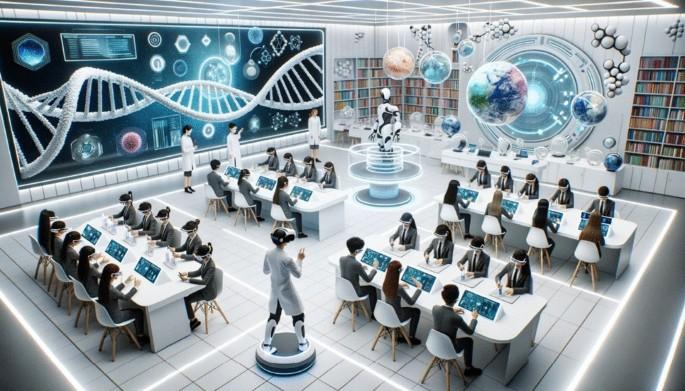AI in Classrooms 2025: Revolutionizing Teaching and Learning for the Next Generation
The landscape of education is rapidly changing, and AI in classrooms is at the forefront of this revolution. As we approach 2025, artificial intelligence is no longer a futuristic concept but a present-day reality reshaping how teachers instruct and how students learn. From personalized learning experiences to intelligent tutoring systems, AI is transforming education for the next generation. In this extensive guide, we’ll explore how AI is revolutionizing teaching and learning in 2025, discuss its benefits, showcase real-life case studies, and offer practical tips for teachers and schools looking to adopt AI solutions.
why AI in Classrooms is the Future of Education
Artificial intelligence brings unparalleled opportunities to customize education,streamline educational processes,and unlock new methods of skill progress. The integration of AI in classrooms empowers both educators and students, making learning more dynamic, inclusive, and future-ready.
- Personalized Learning: AI-powered platforms analyze student data and adapt materials to individual learning paces and preferences.
- Teacher Empowerment: Repetitive administrative tasks are automated, giving teachers more time for creative instruction and student engagement.
- Real-Time Insights: Data-driven dashboards provide instant feedback, enabling timely interventions and support.
- Inclusivity: AI tools help overcome learning barriers for students wiht disabilities or language differences, ensuring equitable access to knowledge.
- Global collaboration: AI connects classrooms across borders, fostering cultural exchange and diverse learning experiences.
Key Applications of AI in Classrooms by 2025
1. Personalized Learning Paths
Modern classrooms leverage AI algorithms to continually assess student strengths and areas for enhancement. These insights allow systems to recommend tailored resources, homework, or even specific quiz questions, ensuring every student receives targeted support and challenges.
2. intelligent Tutoring Systems
AI-powered tutors act as round-the-clock academic assistants, providing explanations, feedback, and practice exercises. These systems can detect when a student is struggling and adjust instruction in real time, making learning more interactive and adaptive.
3. automated Grading and Assessment
Artificial intelligence simplifies the assessment process by grading essays,quizzes,and assignments with remarkable speed and consistency. Teachers can focus on creative parts of evaluation while the AI handles routine tasks, reducing burnout and increasing instructional effectiveness.
4. Enhanced Classroom Management
AI-based classroom management systems monitor classroom engagement, detect behavioral patterns, and send alerts so teachers can intervene before minor issues escalate. This fosters a more supportive and productive learning environment.
5. Language and Accessibility Tools
Language translation, speech-to-text, and content simplification powered by AI make classrooms more inclusive for English language learners and students with special needs. These features open doors to quality education for a wider audience.
Benefits of AI in Classrooms for Teachers and Students
For Teachers
- Reduces administrative burdens,such as grading and reporting
- Identifies struggling students and suggests targeted interventions
- Enables real-time data-driven decision making
- Facilitates personalized curriculum planning
- Supports professional development through AI-powered feedback
For Students
- Learning at their own pace with personalized resources
- immediate,constructive feedback for continuous improvement
- Increased engagement through gamified lessons and AI-powered simulations
- Access to global knowledge bases and cross-cultural collaboration
- Additional support for non-native speakers and students with disabilities
Case Studies: Real-World Success Stories of AI in Education
Finland’s national AI Learning Initiative
By 2025,Finland has implemented an AI-driven national curriculum that adapts in real-time to each student’s needs. Teachers use AI platforms to monitor progress and intervene early, resulting in a 20% increase in overall student engagement and drastically reduced dropout rates.
AI-Supported Special Education in California, USA
A California school district introduced AI-powered tools for students with dyslexia and ADHD. The result: tailored reading exercises, speech recognition, and progress tracking helped increase literacy scores among special needs students by 32% in just two academic years.
Global Virtual Classrooms
Using AI translation and collaboration tools,schools in Japan and Brazil formed joint virtual classrooms.Students not only learned academic subjects together, but gained intercultural understanding, language skills, and global awareness.
First-hand Experience: A Teacher’s Viewpoint
“Incorporating AI into my classroom has been a game changer. Adaptive quizzes allow me to spot which students need more support or extra challenges. Tools like AI chatbots answer students’ routine questions, freeing up my time for one-on-one mentorship.AI isn’t replacing me as a teacher—it’s giving me superpowers to help every student succeed.”
— Sarah M., 7th Grade Science Teacher
Practical Tips for Integrating AI into your Classroom
- Start Small: Identify a single process, like grading quizzes or providing feedback, and introduce an AI tool to streamline it.
- Focus on training: Attend professional development sessions or online workshops to gain hands-on experience with AI-powered education tools.
- Choose Student-Amiable Solutions: Prioritize platforms with intuitive interfaces and robust privacy protections.
- Gather Feedback: Regularly solicit input from students and parents about their experience using AI technologies in the classroom.
- Monitor and Adjust: Use analytics dashboards to track the impact of AI tools, adjusting strategies as needed to maximize effectiveness.
Challenges and Considerations for AI in education
- Privacy and Security: Protecting sensitive student data must be a top priority when adopting AI platforms.
- Equity of Access: Ensuring all students have the necessary devices and internet connectivity is critical to preventing digital divides.
- Teacher Support: Ongoing professional development is essential so educators can confidently integrate AI into their teaching.
- Ethical Use: Schools must establish clear policies to guide ethical and responsible AI usage.
Conclusion: Preparing for the Future with AI in Classrooms
By 2025, AI in classrooms will be an integral part of the educational experience, shaping a generation of curious, capable, and globally-minded learners. While challenges like privacy and access need careful attention, the benefits for teachers and students are too significant to ignore. Schools that embrace AI-powered education are giving their students a competitive edge and preparing them for a rapidly changing world.
The revolution is here—and it’s time to harness the full potential of AI in teaching and learning to inspire, innovate, and uplift the next generation.

